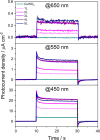Effective Visible Light Exploitation by Copper Molybdo-tungstate Photoanodes
- PMID: 33829150
- PMCID: PMC8016397
- DOI: 10.1021/acsaem.0c01021
Effective Visible Light Exploitation by Copper Molybdo-tungstate Photoanodes
Abstract
The need for stable oxide-based semiconductors with a narrow band gap, able to maximize the exploitation of the visible light portion of the solar spectrum, is a challenging issue for photoelectrocatalytic (PEC) applications. In the present work, CuW1-x Mo x O4 (E g = 2.0 eV for x = 0.5), which exhibits a significantly reduced optical band gap E g compared with isostructural CuWO4 (E g = 2.3 eV), was investigated as a photoactive material for the preparation of photoanodes. CuW0.5Mo0.5O4 electrodes with different thicknesses (80-530 nm), prepared by a simple solution-based process in the form of multilayer films, effectively exhibit visible light photoactivity up to 650 nm (i.e., extended compared with CuWO4 photoanodes prepared by the same way). Furthermore, the systematic investigation on the effects on photoactivity of the CuW0.5Mo0.5O4 layer thickness evidenced that long-wavelength photons can better be exploited by thicker electrodes. PEC measurements in the presence of NaNO2, acting as a suitable hole scavenger ensuring enhanced photocurrent generation compared with that of water oxidation while minimizing dark currents, allowed us to elucidate the role that molybdenum incorporation plays on the charge separation efficiency in the bulk and on the charge injection efficiency at the photoanode surface. The adopted Mo for W substitution increases the visible light photoactivity of copper tungstate toward improved exploitation and storage of visible light into chemical energy via photoelectrocatalysis.
Conflict of interest statement
The authors declare no competing financial interest.
Figures







References
-
- Summary for Policymakers. In Global Warming of 1.5°C. An IPCC Special Report on the impacts of global warming of 1.5°C above pre-industrial levels and related global greenhouse gas emission pathways, in the context of strengthening the global response to the threat of climate change, sustainable development, and efforts to eradicate poverty; Masson-Delmotte V., Zhai P., Pörtner H. O., Roberts D., Skea J., Shukla P. R., Pirani A., Moufouma-Okia W., Péan C., Pidcock R., Connors S., Matthews J. B. R., Chen Y., Zhou X., Gomis M. I., Lonnoy E., Maycock T., Tignor M., Waterfield T., Eds.; World Meteorological Organization: Geneva, Switzerland, 2018.
LinkOut - more resources
Full Text Sources
Miscellaneous
